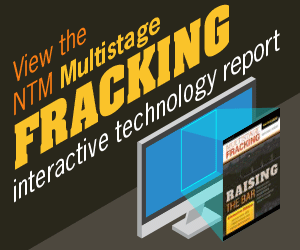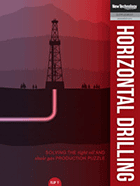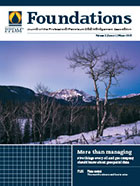The latest issue
Drones Inch Closer To Commercial Use
The announcement Monday that the U.S. Federal Aviation Administration will authorize test sites for unmanned drones in several U.S. states (FAA Picks Diverse Sites to Carry Out Drone Tests) is good news for the energy sector, which could increase efficiency and cut costs by phasing them into operations in a number of different scenarios.
Though emergency services, like police and firefighters, and agriculture have been touted as among the biggest beneficiaries of the use of drones, the oil and gas industry will surely find significant benefits as the use of unmanned aerial vehicles (UAVs), as the industry likes to call them, becomes routine.
As detailed in a New Technology Magazine feature in December (Launch Of The Unmanned Era), the industry is already taking baby steps to make use of the increasingly sophisticated technology in a number of areas, from surveying and inspections of operations and pipelines to environmental monitoring and emergency response.
Ironically, the U.S., the leader in UAV technology development (mainly for military purposes), has lagged in adapting regulations to allow for their non-military testing and use—to the point it risks losing out on a potentially lucrative future commercial market for the devices in all sorts of industries (from the obvious, like agriculture and forestry, environmental monitoring and reclamation, research and emergency response, to such rather outlandish purposes as pizza delivery via DomiCopter and home delivery of parcels from Amazon, if some of the hype can be believed).
By some estimates, the UAV industry is set to grow in leaps and bounds in the next few years (aerospace and defence consultancy the Teal Group says the global market for UAVs is likely to double over the next decade from $5.2 billion to $11.6 billion by 2023), a potential market many in the U.S. don’t want to miss out on, prompting the U.S. Congress to pass the Drones Act to require that commercial UAVs be allowed into U.S. airspace starting in 2015, though many of the rules surrounding domestic use have still to be established.
Current rules in the U.S. for outdoor use and testing of UAVs (not those of the hobby variety, but those designed to perform specific tasks and are often designed to fly autonomously, i.e. with onboard computers and pre-programmed routes) are extremely onerous, requiring, for instance, a licenced pilot, monitoring of local airport radio and prior approvals for every test flight--even for researchers to fly an AUV six inches off the ground in an open field.*
They were onerous enough to force the suspension of “drone journalism” programs last summer, when the University of Missouri and the University of Nebraska-Lincoln received letters from the FAA advising they lacked proper authorization and could be subject to legal action (Drone journalism programs temporarily grounded by FAA). The schools were forced to limit their UAV use to indoor flights while seeking new permissions for outdoor use for newsgathering and research purposes.
Restrictive U.S. regulations left an opportunity for Canada to get a jump on AUV research and development (as countries like Japan and Australia have done), with test sites north of the border, such as that proposed for southeastern Alberta—though that lead might be lost with the U.S. now ready to move forward on sites in its own territory.
Of the 25 hotly contested proposals submitted to the FAA for drone test sites, six were selected, which together cover about 10 states. From an oil and gas point of view, the most interesting to watch is the bid from Alaska, which is to include testing in Hawaii and Oregon as well as Alaska.
Alaska was the location of pilot flights of an Aeryon Scout rotor winged AUV for pipeline inspection undertaken by BP at Prudhoe Bay back in 2012. Alaska was also the site of the first UAV flights for commercial purposes permitted in the U.S. when ConocoPhillips was granted approval last summer to use Insitu's Scan Eagle X200 and AeroVironment's PUMA—fixed wing aircraft with wingspans of about three metres—to be used over the Chukchi Sea to monitor ice floes and migrating whales, as well as potentially to support emergency response crews for oil spill monitoring (ConocoPhillips makes history with drone flight). They have also been tested to help guide ships through sea ice offshore Alaska.
With vast expanses of largely unoccupied territory and relatively open airspace, and a plethora of oil and gas installations, including onshore and offshore exploration and production and a cross-Alaska oil pipeline (and a proposed gas pipeline), the state offers numerous opportunities for UAV development and commercial use. Coincidentally, western and northern Canada offers much of the same.
While there are obvious safety and privacy concerns that need to be dealt with first, made all the more paramount in light of recent revelations of pervasive, secretive U.S. surveillance of communications networks around the world—that may be in violation of the U.S. Constitution—which have eroded trust in government to respect privacy rights and make the task of establishing new rules an even tougher one, the drive to increased AUV use is unstoppable. As they get better and cheaper year after year, their advantages to industry become ever more apparent. The sooner responsible and workable regulations can be put in place and their use piloted and proven in the field, the sooner we can start to appreciate the benefits they may bring, whether that be a safer and more efficient oil and gas business or the delivery of your next pizza to your doorstep.
* An article in Nature (Drones in science: Fly, and bring me data) describes the bureaucratic and time-consuming process in detail, as follows:
With new talent helping to make drones smarter and cheaper, the regulations that control unmanned flight will be the biggest barrier to their expanded use in research…
That is particularly true in the United States, where Federal Aviation Administration (FAA) rules make it laborious to get permission to fly drones outside (except for non-commercial hobbyists, for whom the rules are looser).
“We need permission to go out into a field on campus and fly something that is six inches off the ground,” grouses Eric Frew, head of the Research and Engineering Center for Unmanned Vehicles at UC Boulder. “It is a one-size-fits-all approach.”
The FAA, based in Washington DC, requires that would-be drone operators apply for and receive one of two certificates for their research programme if they want to fly their UAVs outdoors. The applications request a lot of information, “so the FAA can determine if the operation can be conducted without hazard to other aircraft or people and property on the ground”, according to the agency's communications office. This means that certifications are not granted for flights in cities and other crowded areas. These certifications are also limited to a 20-mile-square area (around 32 square kilometres), so when the UC Boulder team took Tempest storm-chasing across swathes of the country, they needed 59 separate permissions.
Once a certification is obtained, usually within 60 days, a group can fly its aircraft during daylight hours in the designated spot for a year or two as long as they file a NOTAM — a Notice to Airmen — in advance with the FAA every time they want to fly.
Each flight also requires a certified pilot. During the March test flight, that was Stachura [PhD student Maciej Stachura of the University of Colorado, Boulder], who spent most of the test staring into the plane's controls on his tablet. The FAA also requires that an observer be on hand to watch for potential collisions and that someone be monitoring the radio from the local airport.





